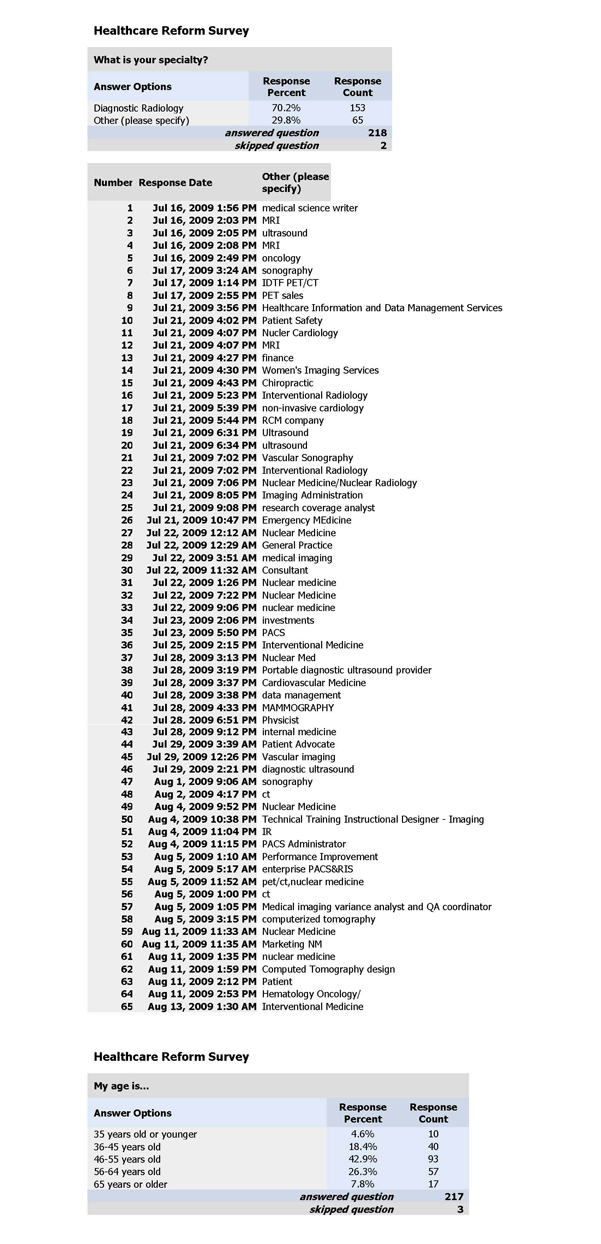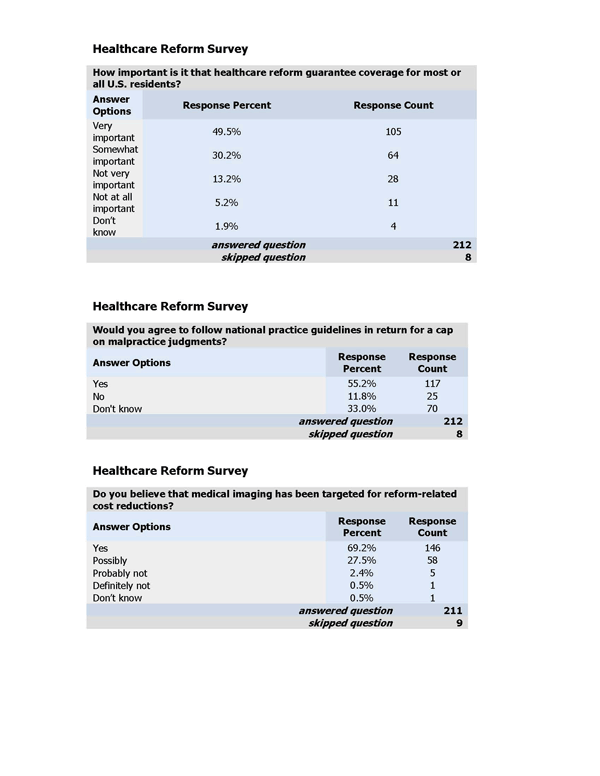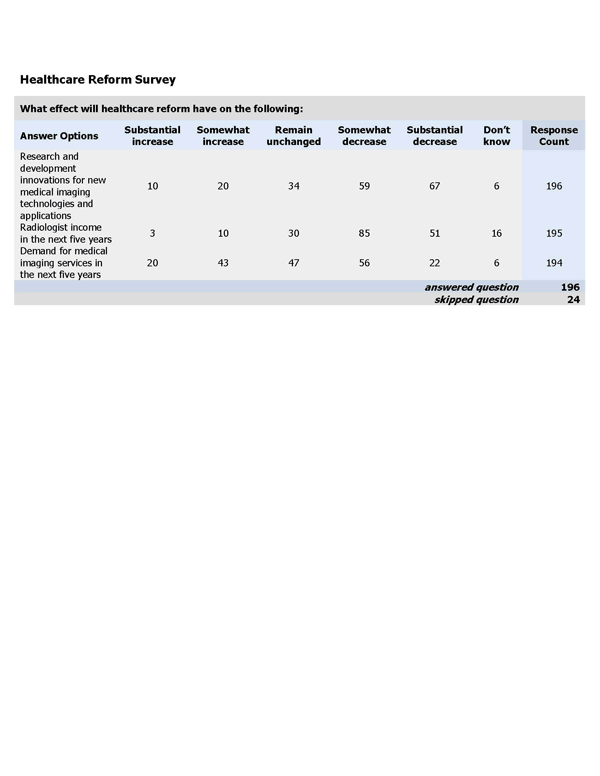Radiologists say yea to universal healthcare access, nay to public option
In an online survey conducted by Diagnostic Imaging, members of the diagnostic radiology community expressed strong support for the idea that healthcare reform should guarantee access to care for most or all U.S. residents. But they were also strongly opposed to the idea of a government-run alternative to private insurance, a strategy now under consideration as a way to achieve wider coverage.
In an online survey conducted by Diagnostic Imaging, members of the diagnostic radiology community expressed strong support for the idea that healthcare reform should guarantee access to care for most or all U.S. residents. But they were also strongly opposed to the idea of a government-run alternative to private insurance, a strategy now under consideration as a way to achieve wider coverage.
A majority said they would agree to follow national practice guidelines in return for a cap on malpractice judgments, agreed that limits on self-referred imaging would reduce imaging costs, and strongly agreed that healthcare costs can be significantly reduced by eliminating inefficient, redundant, or wasteful practices.
The survey, conducted over the course of a month ending in mid-August, drew 220 respondents. Answers to the demographic questions indicated that approximately 180 of them were involved in diagnostic radiology, interventional radiology, and nuclear medicine. The greatest number of respondents, 43%, were between 46 and 55 years of age. Respondents 56 and older outnumbered those 45 and younger 34% to 23%.
In some respects, the survey suggests that the diagnostic imaging community is primed for some of the changes that could take place if healthcare reform measures survive a contentious battle in Congress and are signed into law by President Obama.
A solid majority either strongly agreed or somewhat agreed that inappropriate imaging practices could be reduced through some form of prior authorization such as radiology benefit management companies or automated order-entry. And nearly 70% agreed that medical imaging has been targeted for reform-related cost reductions.
Diagnostic Imaging editorial advisory board members who saw the results generally agreed that there is plenty of waste that can be wrung out of the healthcare system.
"We constantly see inappropriate studies, diagnostic and even interventional, being ordered for ‘medicolegal' reasons, or for other reasons that do not seem to fit the ACR or common sense criteria," said Dr. Eliot Siegel, chief of radiology and nuclear medicine at the VA Maryland Health Care System.
But Siegel doubted that support for prior authorization as a strategy to limit inappropriate imaging studies is all that strong among radiologists.
"Many radiologists who responded to that question would be against prior authorization because they fear that it would be performed inappropriately by people who are not expert in diagnostic imaging or even medicine or surgery," he said. "But I think all would agree that it is self-evident that this approval process would reduce the number of overall studies, including inappropriate imaging ones."
The American College of Radiology has proposed the implementation of electronic decision-support entry systems as an alternative to prior authorization by radiology benefit management companies. It also wants to close the loophole in the federal Stark Law that allows physicians to self-refer patients to office-based imaging equipment in which they have a financial stake. And it has urged President Obama to make malpractice reform part of the healthcare reform package.
In commenting on the survey results, Dr. James Thrall, chairman of the ACR board of chancellors, said, "It's very disappointing that two of the largest savings possibilities for imaging are not faring well in the reform debate: defensive medicine/tort reform and self-referral."
Survey respondents were not optimistic about what healthcare reform could mean for them personally or for the development of the specialty. Slightly more than 64% said that research and development innovations for new medical imaging technologies and applications would somewhat or substantially decrease under healthcare reform.
Nearly 70% said they anticipated that radiologist income in the next five years would decrease somewhat or substantially under healthcare reform. They were nearly evenly split on what healthcare reform could mean for demand for imaging services: 32% anticipated it would increase substantially or somewhat; 40% anticipated it would decrease substantially or somewhat, and 24% were undecided.
Respondents were also asked how satisfied they were with their practice as radiologists. Of 179 who answered that question, 30.7% were very satisfied, 32.4% were somewhat satisfied, 25.7% were neither satisfied nor dissatisfied, 8.9% were somewhat dissatisfied, and 2.2% were very dissatisfied.
Other findings:
- How important is that healthcare reform guarantee coverage for most or all U.S. residents: 49.5% found it very important, and 30.2% found it somewhat important.
- Inappropriate imaging practices can be reduced through some form of prior authorization (either through radiology benefit management companies or through automated order-entry): 19.6% strongly agree, 43% somewhat agree.
- Healthcare costs can be significantly reduced by eliminating inefficient, redundant, or wasteful practices: 57.7% strongly agree, 32.9% somewhat agree.
- A government-run alternative to private insurance is a necessary part of any federal healthcare reform plan: 20.2% strongly agree, 20.2% somewhat agree, 15% somewhat disagree, 41.3% strongly disagree.



Could Lymph Node Distribution Patterns on CT Improve Staging for Colon Cancer?
April 11th 2025For patients with microsatellite instability-high colon cancer, distribution-based clinical lymph node staging (dCN) with computed tomography (CT) offered nearly double the accuracy rate of clinical lymph node staging in a recent study.
The Reading Room Podcast: Current Perspectives on the Updated Appropriate Use Criteria for Brain PET
March 18th 2025In a new podcast, Satoshi Minoshima, M.D., Ph.D., and James Williams, Ph.D., share their insights on the recently updated appropriate use criteria for amyloid PET and tau PET in patients with mild cognitive impairment.
Could Ultrafast MRI Enhance Detection of Malignant Foci for Breast Cancer?
April 10th 2025In a new study involving over 120 women, nearly two-thirds of whom had a family history of breast cancer, ultrafast MRI findings revealed a 5 percent increase in malignancy risk for each second increase in the difference between lesion and background parenchymal enhancement (BPE) time to enhancement (TTE).
AMA Approves Category III CPT Codes for AI-Enabled Perivascular Fat Analysis from CT Scans
April 9th 2025Going into effect in 2026, the new CPT codes may facilitate increased adoption of the CaRi-Heart software for detecting coronary inflammation from computed tomography scans pending FDA clearance of the technology.